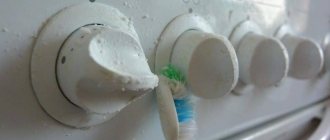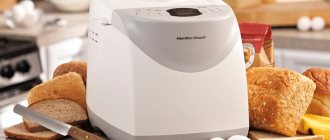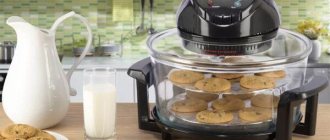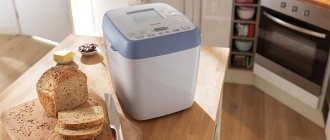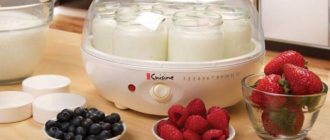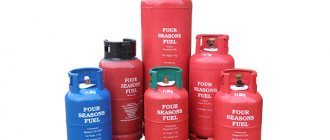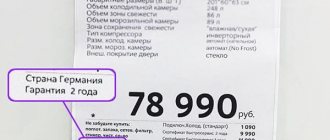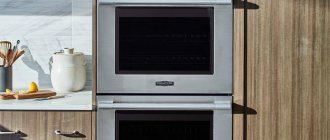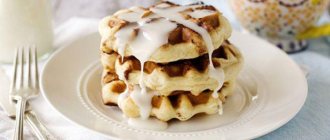Bread plays an important role in our diet. When did you...
Page 2
- Image
- Text
Bread plays an important role in our diet. Have you ever dreamed of baking bread for yourself at home? You can do this with our bread maker. It doesn’t matter whether you have experience or not, you just need to load the ingredients and the bread maker will do the rest. You can easily bake bread, muffins, cakes, without any intervention. But don't rush - first you should
Still, get acquainted with your new bread maker. Take some time for this, and do not be discouraged if your first attempts are not entirely successful. If you don’t want to wait a long time, then the recipe, which is located in the “Quick Start” section, will help you in your first steps. Keep in mind that bread baked in a bread machine is denser than bread bought at a bakery.
INTRODUCTION
FIRST STEPS
Tips for baking bread.
1.
Read the instructions carefully and use the recipes: bread in a bread machine is baked differently than “by hand”!
2.
All ingredients used should be at ambient temperature (unless otherwise stated) and carefully weighed. Measure liquids using the supplied graduated beaker. Measure liquids using the included measuring cup. Use a double scoop, with a tablespoon and a teaspoon.
If the dosage is incorrect
the results will be bad.
3.
Use ingredients before their expiration date. Store them in a cool, dry place.
4.
It is important to measure the exact amount of flour. Therefore, weigh the flour on a kitchen scale. Use dry yeast from a packet. Unless recipes indicate otherwise, do not use baker's yeast. After opening a packet of yeast, use it within no more than two days.
5.
To avoid interfering with the rising of the dough, it is recommended to load all the ingredients into the container from the beginning and try not to open the lid during the cycle (unless otherwise instructed). Carefully follow the order of the bookmarks and the quantities of ingredients indicated in the recipes. Add liquids first, then add solids. The yeast should not come into contact with either liquid or salt.
General order of bookmarks:
Liquids (butter, vegetable oil, eggs, water, milk) Salt Sugar First half of flour Powdered milk Special solid ingredients Yeast
64
Dough bread
Ingredients for preparing a product weighing 1 kg:
- warm water – 450 ml;
- salt – 10 g;
- a mixture of equal amounts of rye and wheat flour – 700 g;
- dry tremors – 6 g.
Step-by-step preparation:
- Pour yeast into warm water, gradually add flour, knead the dough thoroughly.
- Cover the dough with a towel and leave for 4 hours.
- Place the finished product in a bread machine bowl and add salt.
- You can bake bread using the quick baking mode or “French bread”. Set the degree of crust frying at your discretion.
- Allow the finished product to cool for 2-3 hours on a flat wooden surface.
Selecting a program, Using the bread maker
Page 4
- Image
- Text
66
1 > White bread 2 > Quick white bread 3 > French
bread
4 > wholemeal bread
The MENU key selects one of the various programs. The indicator indicates the execution time of the program. Each time you press a number key on the display panel, you go to
following program, from 1 to 12:
The default setting is displayed for each program. Therefore, the exact settings are selected manually.
PROGRAM SELECTION
When you select a program, a sequence of steps is activated that are performed one after another.
1. White bread program, allows you to bake
bread according to most recipes for wheat flour.
2. This program is equivalent to the program
Quick bread, but in quick baking mode. Meat-quiche may seem less fluffy to some.
3. French bread program, corresponds to
recipe for traditional French white bread.
4. Program Whole flour bread, selectable
for baking bread from bran flour.
5. This program is equivalent to the program
White bread, but in quick baking mode. The crumb may seem less airy to some.
6. Sweet bread program, adapted for
recipes for sweet breads with high sugar and fat content.
7. This program is equivalent to the program
Sweet bread, but in quick baking mode. The crumb may seem less airy to some.
8. Very quick bread program
Only suitable for the SUPER QUICK BREAD recipe (page 70).
5 > instant wholemeal bread 6 > sweet
bread
7 > quick baking sweet bread 8 > very fast baking mode
9 > cake 10 > jam 11 > dough 12 > baking only
USING THE BREAD MAKER
9. The Cupcake program allows you to make
Baking and pies using dry yeast.
10. The Jam program is intended only
for automatic preparation of sweet filling in a container.
11. The Dough program is not intended for
baking. It is designed for kneading and rising any yeast dough, such as pizza dough.
12.The Baking Only program carries out
baking in the range from 10 to 60 minutes. It can be selected separately and used: a) in conjunction with the Fresh Dough program, b) to warm or crisp bread that has already been baked and cooled before it is removed from the container. c) to complete bread preparation in the event of a long power outage during the bread baking cycle.
Do not leave the bread maker unattended while program 12 is running.
To interrupt a cycle before it has completed, manually interrupt the program by long pressing the key
.
SELECTING BREAD WEIGHTBread weight is set by default.
SELECTING THE WEIGHT OF BREAD The default weight of bread is 1000 g. This weight is approximate. To obtain bread of other weights, use detailed recipes. In programs 10, 11, 12 the weight of the bread is not adjusted. To set the weight of the dough, press the key to select 500, 750 or 1000 g. The indicator light lights up next to the desired weight. Attention! For some recipes, baking 750g bread is not possible. See recipe book.
Delicious recipe! Salad with beans and Korean carrots recipe
SELECTING GOLDEN CRUST COLOR (BROWNING) Browning intensity is set to MEDIUM [MOYEN] by default. In programs
There is no browning. You can choose from three degrees of browning - LIGHT CRUST (L) - MEDIUM CRUST (P) - DARK CRUST (H) [CLAIR/MOYEN/FONCE]. To set the selection, press the button
indicator lights up the desired degree of browning.
START/STOP To turn on the device, press the button
The indicator light will light up. The countdown will begin. You can interrupt or cancel a delayed program by pressing the button for a long time
Warming up Used in programs 4 and 5 to improve the rise of the dough.
Kneading Ensures the formation of the dough structure, and therefore the ability to rise quickly.
Calm Allows the dough to calm for improved rising quality.
Rising The time the yeast acts during which the bread rises and acquires its aroma.
Baking The dough turns into pulp, ensuring a crispy golden brown crust.
Keep warm Allows you to keep bread warm after baking. However, it is recommended to remove the bread from the pan after baking.
shows what the baking process of a specific program consists of.
Warming up: works only in programs 4 and 5. The stirrer does not work during this time. Heating increases the activity of the yeast and helps bread made from flour, which usually rises poorly, rise.
Kneading: The dough goes through the 1st and 2nd kneading cycles between rising cycles. During these cycles, and in programs 1, 3, 4 and 8, it is possible to add ingredients - dried fruits, olives, slices of lard, etc. A beep indicates when this can be done. The general table (page 78-79) and the “additional” column indicate the operating time of the bread maker. This column indicates the time that is displayed on the indicator when the sound signal sounds. To know more precisely after what time the beep sounds, you need to subtract the time indicated in the “additional” column from the total baking time.
For example, the "optional" column says 2 hours 51 minutes and the "total time" is 3 hours 13 minutes, so ingredients can be added after 22 minutes.
Rising: dough in 1 m, 2 m or 3 m rising cycles.
Baking: Bread in the final stage of baking.
Keep warm: For programs 1, 2, 3, 4, 5, 6, 7 and 8, you can leave the food in the appliance to complete cooking. After baking, the keep warm cycle will automatically start for an hour. During this hour the display will show 0:00. A beep will sound regularly. At the end of the cycle, the device will automatically turn off after several beeps in a row.
In the event of a power outage: if this occurs in...
Page 6
- Image
- Text
68
In the event of a power failure: if this occurs during a work cycle, the program execution is interrupted by a power outage or incorrect operation; The bread machine has a 7-minute power reserve, during which the program is saved. The cycle resumes with
stopping places. After this time, programming is lost.
If two programs are to be run in succession, wait 1 hour before starting the second operation to allow the appliance to cool completely.
PRACTICAL TIPS
You can program your bread maker so that your baked goods are ready at the selected time, up to 13 hours in advance. Delay mode cannot be used for programs 8, 9, 10, 11, 12. This step is activated after selecting the program, degree of browning and weight. The indicator indicates the execution time of the program. Calculate the time between starting the program and the date by which you want to receive your baked goods. The bread machine already includes automatic program cycles. Buttons
And
select
time(
increase and
decrease
time). Use short presses to increase or decrease the time in 10-minute increments and a short beep will sound.
Long presses change the time in increments of 10 minutes continuously. For example, it’s 20:00 now, and you want your bread to be ready at 7:00 tomorrow. Set 11 o'clock using buttons
And
. Click
to the button
. A beep sounds.
A beep will sound and both timer dots will flash. The countdown begins. The operation indicator lights up. If you make a mistake and want to change the time setting, press and hold the button
to sound
signal. The indicator displays the default time. Set the desired time again. Make sure that individual ingredients are not perishable. Do not use the delayed mode when preparing dishes containing raw eggs, yogurt, cheese, or fresh fruit.
Fats and vegetable oil:
fats
give bread fluffiness and taste. This bread also lasts longer. Excess fat slows down the rise of the dough. If you use butter, cut it into small pieces for a more even distribution in the dough, or soften it first. Do not put liquid oil into the bread machine. Avoid contact of fats with yeast, as fat may prevent the yeast from hydrating.
Eggs:
eggs enrich the dough, improve the color of the bread and
contribute to the formation of a tasty crumb. If you use eggs, reduce the amount of liquid ingredients. Crack the egg and add liquid to the volume specified for liquid in the recipe. Recipes call for a medium 50 gram egg; for larger eggs add a little flour,
for smaller eggs, reduce the amount of flour.
Milk:
you can use fresh or
powdered milk. If you are using powdered milk, add water to the original volume. If you are using fresh milk, you can also add water - the total volume of liquid should be equal to the volume specified in the recipe. Milk also has an emulsifying effect, resulting in more uniform cavities and a better-looking crumb.
Water:
water saturates and activates the yeast. She
also saturates the starch contained in the flour and ensures the formation of crumb. Water can be replaced, partially or completely, with milk or other liquids. Liquids should be at room temperature when added.
OTHER PROGRAM SETTINGS
INGREDIENTS
PROGRAMS
Spicy gluten free bread.
This program allows you to bake bread recipes with low sugar and fat content. Please note that: • Gluten-free bread does not rise as well as regular bread. It will have a denser consistency and lighter color than regular bread. • Mixtures from different manufacturers give different results: recipes may need to be adjusted. Therefore, it is recommended to test the mixture first.
Bread with sun-dried tomatoes
Ingredients
| Water 30°C 380 ml | Quinoa ground in a blender* 40 g. |
| Olive oil 40 ml | Corn flour* 40 gr. |
| Provençal herbs 3 tsp | Gluten-free mixture* 340 g. |
| Dry gluten-free yeast 2 tsp. | Sun-dried tomatoes 150 gr. |
| Salt 1 tsp. |
Place all ingredients in a bowl in the order shown.
Mix the ingredients (*) in advance and sift them. Select program 1, set the crust color level and press START. Dry the sun-dried tomatoes on a paper towel and add them after the beep to the bread maker. Gluten-free flour: When using large quantities of this flour, you should select a program for baking gluten-free bread. There are many types of gluten-free flour. The most famous are buckwheat flour, rice flour (white or whole grain), quinoa flour, corn flour, chestnut flour, millet flour and sorghum flour. When making gluten-free bread, to recreate the elasticity of gluten, it is necessary to mix several types of non-bread flour and add thickeners.
Sweet gluten free bread.
The program allows you to bake bread according to recipes with added sugar and fat. It is recommended to use a ready-made mixture. Mix the ingredients (*) in advance and sift them. Select the program, crust color and press the START button. When you hear the beep, add the following ingredients (**).
Brioche
| Ingredients | Schär mixture | Valpiform mixture |
| Milk 30°C* | 140 ml | 200 ml |
| Beaten eggs* | 4 | 4 |
| Salt* | 1 tsp | 1 tsp |
| Sugar* | 90 gr. | 90 gr. |
| Melted butter* | 140 gr. | 140 gr. |
| Gluten-free mixture | 400 gr. | 400 gr. |
| Instant yeast | 2 tsp | 2 tsp |
Thickeners for Gluten-Free Bread: Xanthan gum and/or guar can be added to the mixture to obtain the correct consistency and give elasticity to breads that typically contain gluten. Ready-to-eat gluten-free mixes make it easier to produce gluten-free bread because they contain thickeners and have the advantage of being completely gluten-free and some of them being biological in origin. Ready-to-use gluten-free mixtures from different manufacturers give different results.
Gluten free cake/cupcake.
This program allows you to bake gluten-free muffins with the addition of baking powder. It is recommended to use a ready-made mixture. Mix the ingredients (*) until pale in color and transfer to a bowl. Add pre-sifted ingredients (**). Select program 3, crust color and press START. After the beep, add ingredients (***)
Pie with cheese and ham
Ingredients
| Milk 30°C** – 80 ml | Confectionery Premix** – 300 g. |
| Beaten eggs* – 4 | Yeast** - 2 tsp. |
| Olive oil* - 100 g. | Chopped ham*** - 250 g. |
| Salt* - 1 tsp. | Pitted chopped olives*** - 40 g. |
| Pepper - 1 gr. | Shredded Gruyere cheese*** – 110 g. |
| Melted butter - 20 g. |
Warnings for using gluten-free bread programs To prepare gluten-free breads or cakes, use menus 1, 2 and 3. Only one weight can be set for each program. Gluten-free breads and pies are suitable for people who are intolerant to gluten, which is found in most grains (wheat, barley, rye, oats, etc.). A gluten-free diet is often recommended in various health programs. It is important to avoid mixing gluten-free mixture and different flours when baking. Before preparing gluten-free bread or muffins, take extra care to clean the bowl, paddle, and all tools. Also make sure that the yeast you use is gluten-free. Gluten-free recipes have been developed using flour mixtures (also called "ready-to-eat mixtures") to bake Schär or Valpiform gluten-free breads. 4. Classic bread /5. Classic quick bread.
These programs allow you to bake white bread like soft bread. Program 5 makes it faster, but requires the use of more yeast.
Quick bread
| Ingredients | 500 gr. | 750 gr. | 1000 gr. |
| Warm water 35 degrees. WITH | 210 ml | 285 ml | 360 ml |
| Sunflower oil | 3 tsp | 1 tbsp. | 1.5 tbsp. |
| Salt | 0.5 tsp | 1 tsp | 1.5 tsp. |
| Sugar | 2 tsp | 3 tsp | 1 tbsp. |
| Powdered milk | 1.5 tbsp. | 2 tbsp. | 2.5 tbsp. |
| Bread flour | 325 gr. | 445 gr. | 565 gr. |
| Dry yeast | 1.5 tsp. | 2.5 tsp. | 3 tsp |
Place all the ingredients in the bowl in the order shown. Select program (4 or 5), weight of bread, crust color and press the START button.
French bread.
The program allows you to bake traditional French white bread with a thicker crust. Bread with honey
| Ingredients | 500 gr. | 750 gr. | 1000 gr |
| Water | 140 ml. | 210 ml | 280 ml |
| Honey | 70 gr. | 100 gr. | 135 gr. |
| Dry yeast | 0.5 tsp | 0.75 tsp | 1 tsp |
| Flour | 225 gr. | 340 gr. | 450 gr. |
| Salt | 0.75 tsp | 1 tsp | 0.5 tsp |
| Sliced Roasted Almonds** | 70 gr. | 100 gr. | 135 gr. |
Place all ingredients in the bowl in the order shown. Select the program, bread weight, crust color and press the START button. When you hear the beep, add the following ingredients (**).
Sweet bread.
This program is suitable for brioche-type recipes that contain more fat and sugar. When using ready-made mixtures, do not make dough weighing more than 750 g.
Cake
| eggs | 3 pcs. | Butter | 160g. |
| milk | 100ml. | salt | 1 tsp |
| sugar | 8-9 tbsp | flour | 420g |
| yeast | 2.5 tsp. | raisins (nuts, candied fruits | taste |
For those who do not like very sweet cakes, you can use 4-5 tbsp sugar. You can add ground cinnamon, nutmeg, and turmeric (for color). Time about 2.5 - 3 hours.
Whole wheat bread.
This program should be selected when baking bread using whole grain flour. Place all ingredients in the bowl in the order shown. Select the program, bread weight, crust color and press the START button.
Homebaked bread
| Ingredients | 500 gr. | 750 gr. | 1000 gr. |
| Water | 200 ml | 270 ml | 355 ml |
| Sunflower oil | 1.5 tbsp. | 2 tbsp. | 2.5 tbsp. |
| Salt | 1 tsp | 1.5 tsp. | 2 tsp |
| Sugar | 1.5 tsp. | 2 tsp | 2.5 tsp. |
| Powdered milk | 0.5 tbsp | 0.5 tbsp | 1 tbsp. |
| Bread flour | 170 gr. | 235 gr. | 310 gr. |
| Whole wheat flour | 80 gr. | 110 gr. | 145 gr. |
| Whole rye flour | 80 gr. | 110 gr. | 145 gr. |
| Dry yeast | 0.5 tsp | 1 tsp | 1.5 tsp. |
Whole grain quick bread.
This program allows you to cook bread faster using whole grain flour. Wholemeal bread
| Ingredients | 500 gr. | 750 gr. | 1000 gr. |
| Water | 205 ml | 270 ml | 355 ml |
| Sunflower oil | 1.5 tbsp. | 2 tbsp. | 3 tbsp. |
| Salt | 1 tsp | 1.5 tsp. | 2 tsp |
| Sugar | 1.5 tsp. | 2 tsp | 3 tsp |
2 tsp Bread flour 130 gr. 180 gr. 240 gr. Unsifted flour 200 gr. 270 gr. 360 gr. Dry yeast 1 tsp. 1 tsp Place all ingredients in the bowl in the order shown. Select the program, bread weight, crust color and press the START button.
Rye bread.
This program should be selected when using large quantities of rye flour or other similar grains (e.g. buckwheat, spelt). I recommend using ready-made mixtures.
Yeast dough.
This program allows you to prepare pizza dough, bread dough and waffle dough. This program does not bake bread. Place all ingredients in the bowl in the order shown. Select a program and press the START button.
Pizza dough
| Ingredients | 500 gr. | 750 gr. | 1000 gr. |
| Water | 160 ml | 240 ml | 320 ml |
| Olive oil | 1 tbsp. | 1.5 tbsp. | 2 tbsp. |
| Salt | 0.5 tsp | 1 tsp | 1.5 tsp. |
| Bread flour | 320 gr. | 480 gr. | 640 gr. |
| Dry yeast | 0.5 tsp | 1 tsp | 1.5 tsp. |
Paste.
The program allows you to prepare pasta dough or cake dough. We make yeast-free dough. Place all ingredients in the bowl in the order shown. Select a program and press the START button.
Paste
| Ingredients | 500 gr. | 750 gr. | 1000 gr. |
| Water | 45 ml | 50 ml | 70 ml |
| beaten eggs | 150 gr. | 200 gr. | 275 gr. |
| Salt | 1 pinch | 0.5 tsp | 1 tsp |
| Wheat flour | 375 gr. | 500 gr. | 670 gr. |
Pie/cupcake.
Allows you to prepare pies or muffins with the addition of baking powder. Only the 750g setting is available for this program. Place all ingredients in the bowl in the order shown. Mix all ingredients together until they form a homogeneous mass. Select program No. 13, crust color and press the START button. The cake mode is designed in such a way that after the bread machine has kneaded the main mass, it emits a signal to add additional ones. ingredients, nuts, candied fruits and so on.
Almond cake
| Beaten eggs* | 200 gr. | Sugar | 190 gr. |
| Salt* | 1 pinch | Soft butter | 145 gr |
| Almond flour | 180 gr. | Baking flour | 210 gr. |
| Dark rum | 3 tbsp. | Baking powder | 3 tsp |
Baking.
This program is designed for baking durations from 10 to 70 minutes. It can only be used: a) after a program for preparing yeast dough, b) to reheat or crisp bread that has already been baked but has cooled, c) to complete the cooking process in the event of a prolonged power outage while baking bread.
Porridge.
This program allows you to cook porridge and rice pudding with milk.
Oatmeal porridge: Yield: 650 gr.
Milk 600 ml Oatmeal 100 gr. Salt or sugar 1 tsp. Place the ingredients in the bowl in the order indicated. Select the specified program. Increase the program time to 15 minutes using the + button and press START. Tip: If you prefer a thicker porridge, increase the cooking time by 5 minutes. For a fuller flavor, you can add honey, cinnamon, chopped dried apricots and shelled hazelnuts at the end of cooking.
Cereals.
This program allows you to cook various cereals: rice, buckwheat, etc.
Rice porrige
Yield: 500 gr. Rice 200 gr.; Water 400 ml; Salt 1/2 tsp. Place the ingredients in the bowl in the order shown. Select program 16. Increase the program time to 30 minutes using the “+” button and press START.
Jam/jelly.
Allows you to prepare homemade jam.
Jam Cut fruit: strawberries, peach, rhubarb or apricot 580 gr. Sugar 360 gr. Lemon juice 1 Pectin 15 gr. Place all ingredients in the bowl as indicated and press START. Important. When starting programs 15, 16 and 17, be careful because when you open the lid, hot steam and condensation will escape from the container.
Special programs of the Pain & Délices bread machine:
Yogurt.
This program allows you to prepare yogurt using pasteurized cow, goat or soy milk.
Place the yogurt cup in the container (without lid or whey filter). Once prepared, store the yogurt in a cool place and consume it within 7 days. Select program 18. Increase the program time to 9 hours using the “+” button and press START. Yogurt Yield 850 ml Whole milk 750 ml + Yogurt 125 gr. Pour the ingredients into a yogurt cup and stir until smooth. Place the container with the lid in the bowl, removing the knives from it. 19. Drinking yogurt.
This program allows you to prepare drinking yoghurts based on pasteurized milk. Place the yogurt cup in the container (without lid). Stir well before use. Once prepared, store the yogurt in a cool place and consume it within 7 days. Low fat milk 900 ml Yogurt 125 gr. Sugar 3 tbsp.
Cottage cheese.
The program allows you to prepare cottage cheese based on sour cow's or goat's milk or kefir. Insert the whey cup into the yogurt cup (without lid) and place it in the container. Pour kefir into a glass. Select program 20, increase its time to 45 minutes by pressing the “+” button and press START. Once cooking is complete, strain the curd for 1-2 minutes and add the garlic, dill and salt. This program requires a pumping step. Cottage cheese Yield 550 gr. Ingredients: Kefir 1.5 l; Garlic 45 ml; Dill 1 (125 gr.); Salt 1 pinch.
PRINCIPLE OF OPERATION OF THE BREAD MAKER
The cycle table shows different stages, depending on the selected program. A visual indicator shows the current stage of program execution. 1. Kneading the dough This program allows you to form the structure of the dough so that it rises well. During this cycle you have the opportunity to add ingredients to the dough: dried fruits, olives, etc... A sound signal indicates when to do this. Look in the cycle table. The “additional” column indicates the time that will be displayed on the screen of your device when the beep sounds. 2. Dough resting During this program, the dough “rests”, which allows you to improve its quality. You can program the device for an interval of up to 15 hours so that the bread is ready at the time you need. This step is carried out after selecting the program, degree of browning and weight. The program execution time will be displayed on the screen. To adjust the delayed start time of the program, press the and buttons. The device will display the total time until the end of the cooking process. The icon will light up. Press the button to enable the delayed start program. If you make a mistake or want to change the time setting, long press the button until you hear a beep. The default time will be displayed on the screen. Repeat the procedure. Important. Some ingredients are perishable. Do not use the delayed start program for recipes containing: unpasteurized milk, eggs, yoghurt, cheese, fresh fruit. 3. Dough rising The time during which the yeast works, causing the dough to rise and acquire flavor. 4. Baking During this program, the crumb of the bread is formed, and the crust becomes golden brown and crispy. 5. Keep warm This program allows you to keep bread warm for 1 hour after baking. However, it is recommended to remove the bread from the pan after baking. During the hour of keeping the bread warm, the indicator shows the value 0:00. At the end of the cycle, the device beeps several times and then turns off automatically.
CYCLE TABLE
| Etc | WEIGHT(g) | CRUST | TOTAL TIME (h) | PREPARATION OF THE DOUGH (Kneading - Settling - Rising) (h) | BAKING (h) | ADDITIONAL (h) |
| 1 | 1000 | 1-3 | 2:43 | 0:55 | 1:48 | 2:29 |
| 2 | 1000 | 1-3 | 2:45 | 1:00 | 1:45 | 2:37 |
| 3 | 750 | 1-3 | 2:15 | 1:30 | 0:45 | 2:07 |
| 4 | 500/750/1000 | 1-3 | 2:57/3:02/3:07 | 0:48/0:53/0:58 | 2:09 | 2:28/2:33/2:38 |
| 5 | 500/750/1000 | 1-3 | 1:25/1:30/1:35 | 0:45/0:50/0:55 | 0:40 | 1:17/1:22/1:27 |
| 6 | 500/750/1000 | 1-3 | 2:55/3:00/ 3:10 | 0:50/0:55/1:05 | 2:05 | 2:33/2:38/2:48 |
| 7 | 500/750/1000 | 1-3 | 3:20/3:25/3:30 | 0:40/0:45/0:50 | 2:40 | 2:40/2:45/2:50 |
| 8 | 500/750/1000 | 1-3 | 2:40/2:45/ 2:50 | 0:55/1:00/1:05 | 1:45 | 2:23/2:28/2:33 |
| 9 | 500/750/1000 | 1-3 | 3:35/3:40/3:45 | 0:55/1:00/1:05 | 2:40 | 3:22/3:40/3:45 |
| 10 | 500/750/1000 | 1-3 | 2:40/2:45/2:50 | 0:55/1:00/ 1:05 | 1:45 | 2:23/2:28/2:33 |
| 11 | — | — | 1:09 | — | 1:09 | 0:30 |
| 12 | — | — | 0:15 | 0:15 | — | — |
| 13 | 1000 | 1-3 | 1:45 | 0:25 | 1:20 | — |
| 14 | — | 1-3 | 0:10->1:10 | 0:10->1:10 | — | — |
| 15 | — | — | 0:10->0:45 | — | — | — |
| 16 | — | — | 0:10->0:45 | — | — | — |
| 17 | — | — | 0:50 | — | — | — |
| 18 | — | — | 07:00->16:00 | — | — | — |
| 19 | — | — | 04:00->10:00 | — | — | — |
| 20 | — | — | 0:10->03:00 | — | — | — |
Note: the total duration does not include the time it takes to keep the bread warm.
DELAYED START PROGRAM
You can program the device for an interval of up to 15 hours, so that the bread is ready at the time you need. This step is carried out after selecting the program, degree of browning and weight. The program execution time will be displayed on the screen. To adjust the delayed start time of the program, press the “+” and “-“ buttons. The device will display the total time until the end of the cooking process. The “:” icon will light up. Press the Start/Stop button to activate the delayed start program. If you make a mistake or want to change the time setting, hold down the Start/Stop button until you hear a beep. The default time will be displayed on the screen. Repeat the procedure. Important: Some ingredients are perishable. Do not use the delayed start program for recipes that contain: unpasteurized milk, eggs, yoghurt, cheese, fresh fruit.
USEFUL TIPS
1. All ingredients used must be at room temperature (unless otherwise stated) and must be accurately weighed. Measure liquids using the supplied graduated glass. Use the included spoon to measure teaspoons on one side and tablespoons on the other. Incorrect measurement will lead to unsatisfactory results. The bread making process is very sensitive to temperature and humidity conditions. If the room is very hot, it is recommended to use cooler liquids than usual. Likewise, in case of low temperatures, it may be necessary to heat the water or milk (but the temperature should never exceed 35°C). 2. Use the ingredients before the expiration date and store them in a cool, dry place. 3. Flour should be accurately weighed using a kitchen scale. Use active dry baker's yeast, which comes in packets. 4. Do not open the cover while the device is in use (unless otherwise specified). 5. Follow the exact order in which you enter the ingredients and the quantities indicated in the recipes. Add liquids first and then solids. Yeast should not come into contact with liquids or salt. Too much yeast will disrupt the structure of the dough, causing it to rise too much and then collapse during cooking. The usual order to follow is: ––Liquids (softened butter, vegetable oil, eggs, water, milk) ––Salt ––Sugar ––First half of flour ––Powdered milk ––Additional solid ingredients ––Second half of flour – –Yeast 6. In the event of a power outage lasting less than 7 minutes, the bread maker will remember the current state and continue to operate after the power supply is restored. 7. If you want to run 2 bread cycles, wait approximately 1 hour between the two cycles so that the bread maker cools down and does not affect the quality of the bread. 8. While removing the bread, you may find that the blade is stuck in it. In this case, use a hook to carefully remove it. To do this, insert the hook into the mixer shaft and then pull to remove it. • To avoid the formation of lumps, sift the flour mixture along with the yeast. • When starting the program, you should help the kneading process: move the unmixed ingredients remaining on the walls to the center of the container using a non-metallic spatula.
INGREDIENT INFORMATION
Yeast: Baker's yeast is needed to make bread. They come in different forms: fresh in small cubes, active dry, which must be combined with water, or instant dry. Example: selecting the amount of liquid. Exception: Pie/cupcake batter should remain fairly runny. Too runny OK Too dry • To avoid lumps, sift the flour mixture together with the yeast. • When starting the program, you should help the kneading process: move the unmixed ingredients remaining on the walls to the center of the container using a non-metallic spatula. Yeast should be added directly into the bread machine container along with other ingredients. Grind the fresh yeast well between your fingers to promote better distribution in the dough. Follow the prescribed dosage (see table of equivalents below). Equivalent quantities/weight ratios for dry and fresh yeast:
| Dry yeast (in tsp) | 1 | 1,5 | 2 | 2,5 | 3 | 3,5 | 4 | 4,5 | 5 |
| Fresh yeast (in grams) | 9 | 13 | 18 | 22 | 25 | 31 | 36 | 40 | 45 |
Flour: Unless otherwise noted, recipes recommend using wheat flour. When using special flour mixtures for brioche or other breads, do not exceed the total amount of dough 750 g (flour + water). Depending on the amount of flour, bread baking results may also vary. • Store flour in an airtight container as it reacts to changes in climate conditions (humidity). By adding oats, bran, sprouts, rye or whole grains to the dough, the bread will be denser and less airy. • The more whole grain the flour is, i.e. contains particles of the shell of bread grains (T>55), the less the dough will rise, and the more dense the bread will be. • On sale you will also find ready-made mixtures for baking bread. To use such mixtures, refer to the manufacturer's recommendations. Sugar: Do not use lump sugar. Sugar feeds the yeast, gives the bread a good flavor and makes the crust more golden. Salt: helps regulate yeast activity and adds flavor to bread. Before starting the bread making process, the salt should not come into contact with the yeast. Salt also improves the texture of the dough. Water: Water hydrates and activates yeast. It also moisturizes the starch contained in the flour and promotes the formation of bread crumb. Water can be completely or partially replaced with milk or other liquids. Use liquids at room temperature, except for gluten-free breads, which require warm water (approximately 35°C). Fats and vegetable oils: Fats make bread softer. Thanks to them, bread is also stored better and longer. Too much fat will slow down the rise of the dough. If using butter, cut it into small pieces or soften it. Do not add melted butter. Do not allow fats to come into contact with the yeast, as the fat can interfere with the hydration of the yeast. Eggs: Improve the color of bread and help form the bread crumb. If using eggs, reduce the amount of liquid accordingly. Crack the egg and add liquid until the amount specified in the recipe is reached. The recipes are based on an average egg weight of 50g. For larger eggs, add a little flour; if the eggs are smaller, add a little less flour. Milk: Milk has an emulsifying effect, resulting in smoother pores and an improved crumb appearance. You can use fresh or powdered milk. If you are using powdered milk, add water in the same amount as milk should be added: the total volume should correspond to the volume specified in the recipe.
SELECTION OF INGREDIENTS FOR PREPARING YOGURT
Read: Yogurt in a slow cooker Tefal Milk What kind of milk should I use? Any type of milk can be used (for example, cow, goat, sheep, soy and other plant-based milks). The consistency of yogurt may vary depending on the milk used. This machine can use unpasteurized milk, shelf-life milk and all types of milk listed below: • Shelf-life sterilized milk: UHT whole milk gives the yogurt a thicker consistency. If you use half-skimmed milk, the consistency of the yogurt will become thinner. Alternatively, you can use half-skimmed milk and add 1 or 2 tablespoons of milk powder to it. • Whole milk : Using this milk makes the yogurt creamier, with a thin film on the surface. • Unpasteurized milk (farm milk): This type of milk must be boiled beforehand. It is recommended to boil milk for a fairly long period of time. Then let it cool before pouring it into the device. • Milk powder : This type of milk gives the yogurt a very creamy consistency. Starter for yogurt The starter can be: • Natural yogurt, purchased in a store, with the longest shelf life possible. • Yogurt starter agent or lactic acid bacteria. In this case, follow the recommendations in the instructions for the starter. Such starter cultures can be purchased in supermarkets, pharmacies and some stores selling medical supplies. • One of your newly prepared yoghurts – this should be natural yoghurt, as fresh as possible. This procedure is called cultivation. Important: The properties of starter cultures can be destroyed when exposed to too high temperatures. Fermentation Duration • Depending on the base ingredients used and the desired result, the yogurt fermentation process takes between 6 and 12 hours. Once the preparation process is complete, refrigerate the yogurt for at least 4 hours and consume it within 7 days. Rennet starter (for curds) To make curds, you can use rennet starter or an acidic liquid such as lemon juice or vinegar to curdle the milk.
Baked bread is very sensitive to temperature and humidity...
Page 7
- Image
- Text
69
Baked bread is very sensitive to temperature and humidity. If the room temperature is very high, it is recommended to use a cooler liquid than usual. At low temperatures, you may have to heat the water or milk (to a temperature no higher than 35°C).
Sometimes it is also useful to check the condition of the dough during kneading: it should be a homogeneous mass that easily lags behind the walls of the container: > if there is unkneaded flour left, add
some water,
> otherwise it may be necessary
add flour.
Flour or water should be added very carefully (one tablespoon at a time), and ensure the quality of the dough before adding new portions.
A common mistake is to assume that adding yeast will make the dough rise better. On the contrary, if there is too much yeast, the structure of the dough becomes more fragile, it rises high and falls during baking. The quality of the dough can be assessed by lightly tapping it with your fingers - the dough should “resist” indentation, and the dents on it should gradually smooth out.
Flour:
The weight of flour depends greatly on its type. IN
Depending on the quality of flour, the resulting baked goods may also change. Store flour in an airtight container, as it can react to fluctuations in temperature and humidity by absorbing or releasing moisture. Adding oat flour, bran, wheat germ, rye flour, and finally whole grains to the dough produces a heavier and less fluffy bread. It is recommended to use premium flour unless otherwise specified in recipes. The results are also influenced by how much the flour is sifted - the more whole it is (that is, if it contains particles of the shell of wheat grains), the less the dough rises, and the denser the bread turns out. You can also find ready-made baking dough in stores. When using this test, follow the manufacturer's instructions. In general, when choosing a program, adhere to the requirements for finished baked goods. For example, for wholemeal bread, use program 4.
Sugar:
preferable use
refined sugar or honey. Never use refined sugar or lump sugar. Sugar feeds the yeast, gives the bread flavor, and improves the golden brown color of the crust. Salt: Salt adds flavor to baked goods and helps regulate yeast activity. It should not come into contact with the yeast. Thanks to salt, the dough turns out hard, compact, and does not rise very quickly. Salt also improves the texture of the dough.
Yeast:
yeast ensures the dough rises.
Use active dry yeast in packets. The quality of yeast varies and it does not always expand at the same rate. So the quality
bread may vary depending on the yeast used. Old yeast or improperly stored yeast does not work as well as freshly opened dry yeast. All proportions in recipes are for dehydrated yeast. If you use fresh yeast, you should take triple the amount (by weight) and dilute it with a small amount of warm, slightly sugared water for a more effective effect. Dry yeast can be sold in the form of small balls, they should also be diluted with a small amount of warm, lightly sugared water. This yeast is used in the same proportions as dry yeast in sheets, but we recommend using dry yeast in sheets as it is easier to prepare.
Additives (olives, oils, etc.):
Can
use your own recipes, adding any desired additives; however, you should: > strictly observe the time indicated by the sound
signal for introducing additives, especially the most delicate ones,
> keep in mind that the hardest grains (e.g.
flaxseed or sesame seeds) can be added
at the very beginning of kneading, to make it easier to use the bread maker (for example, when manually
setting the time),
> carefully drain moisture from very wet
ingredients (olives),
> lightly roll fatty ingredients in flour to
obtaining a more homogeneous dough,
> don't add them in too much quantity - this is
may damage the test.
PRACTICAL TIPS
Sourdough bread
For those who follow a healthy diet, you can make bread in a bread machine without using yeast.
How to prepare sourdough:
- Mix 250 of any flour, 250 ml of water, add 6 ml of honey and vegetable oil. Make a cut on the finished mixture.
- Place the container with the starter in a warm room for three days, after covering it with film. The readiness of the product is indicated by bubbles that appear on the surface.
- Dilute the finished starter with water until it becomes thick sour cream, leave until bubbles appear.
- Do the procedure again. If the consistency is very liquid, you can add a little flour.
Store the finished starter in the refrigerator. Before use, pour the required amount and let it warm up at room temperature.
